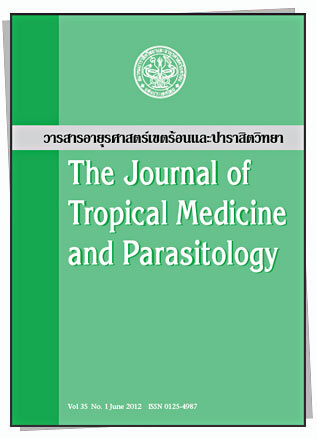Intestinal Helminthiases in Two Communities of Phitsanulok Province, Northern Thailand
Main Article Content
Abstract
Abstract
Most serious helminthic infections occur in tropical regions, particularly in lesser-developedcountries, including outreach rural communities in Thailand. This study investigated theprevalence of helminthic infections in the people of Ban Chat Trakan Village in Chat Trakarn District,and Ban Mung Village, Noen Maprang District, Phitsanulok Province, in northern Thailand. Theformalin ethyl acetate concentration technique was used to detect parasites in fecal samples. In total,286 people were recruited for this study: 153 from Ban Mung Village and 133 from Ban Chat Trakan.The percentage of helminthic infections in both communities was low, with an overall infection rateof 5.6%; which comprised 2.4% Strongyloides stercoralis, 1.6% hookworm, and 0.8% Taenia spp andHymenolepis nana. In addition, the ‘Scotch tape’ method was used to recover pinworm (Enterobiusvermicularis) eggs, giving an overall enterobiasis infection rate of 10.5%. All positive cases weretreated with an anthelminthic drug. Health-education campaigns for the prevention of helminthicinfections, and selective treatment, are needed for these two communities.
Keywords: prevalence; intestinal helminthiasis; Phitsanulok; Thailand

